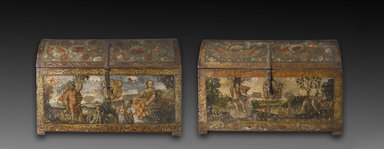Browse

| Accession # | 2011.86.3 |
|---|---|
| Culture | Peruvian |
| Title | Chest |
| Date | ca. 1700 |
| Medium | Polychromed and gilded leather, wood and iron |
| Dimensions | 22 13/16 x 33 1/16 x 17 5/16 in. (58 x 84 x 44 cm) |
| Credit Line | Bequest of William H. Herriman and Caroline H. Polhemus, gift Cornelia E. and Jennie A. Donnellon, by exchange and A. Augustus Healy Fund |
| Location | BMA, 5Q12-LUCE, Unit 34, Shelf F |
| Description | One of two |
Curatorial Remarks: These two Peruvian leather-bound chests are painted on the front with large allegorical figures flanking smaller Old World aristocrats. The sides show figures with their servants, including music-making dwarfs, modeled on European representations of such entertainers at the Spanish court, on the grounds of a country estate.
The chests were most likely commissioned by a member of Peru’s privileged class for proud display in a reception room, where they would have functioned as signifiers of their owner’s erudition and education. Inside were stored fine imported textiles, which in colonial Peru were worth more than their weight in silver. The chests’ four allegories of Fire, Earth, Wind, and Water on the front panels are based on sixteenth-century Flemish prints (see illustration at right, the model for the figure of Fire), whereas the dining scene on one of the sides has a Mexican print source (see illustration at far right).
Estos dos baúles peruanos forrados en cuero están pintados en el frente con grandes figuras alegóricas flanqueando a aristócratas del Viejo Mundo, representados a menor escala. Los lados muestran a figuras y sus criados; entre ellos se incluyen músicos enanos, representados de acuerdo al formato europeo empleado en la corte española. La escena sucede en los predios de una propiedad campestre.
Los baúles fueron probablemente comisionados por algún miembro de la clase privilegiada del Perú para ser orgullosamente expuestos en su sala de recepción. Allí habrían funcionado como indicadores de la erudición y educación de su propietario. Dentro de ellos se guardaban finos textiles importados, que en el Perú colonial valían más que su peso en plata. Las cuatro alegorías, Fuego, Tierra, Viento y Agua, en los paneles delanteros del baúl están basadas en imágenes flamencas del siglo XVI (ver ilustración superior, el modelo de la figura del Fuego), mientras que la escena del banquete en uno de los lados proviene de un grabado mexicano (ver ilustración inferior).